MERCEDES-BENZ E-CLASS CABRIOLET 2018 Owner's Manual
Manufacturer: MERCEDES-BENZ, Model Year: 2018, Model line: E-CLASS CABRIOLET, Model: MERCEDES-BENZ E-CLASS CABRIOLET 2018Pages: 498, PDF Size: 6.28 MB
Page 351 of 498
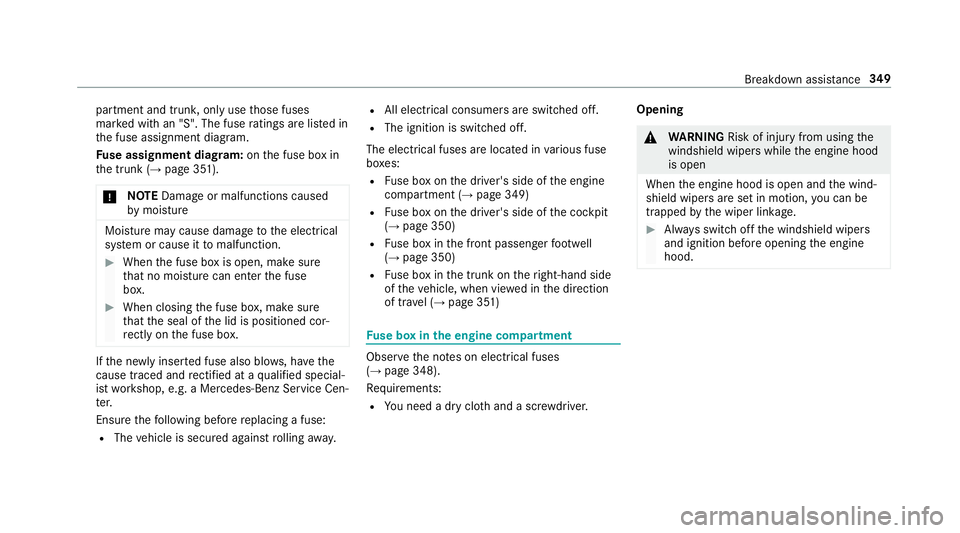
partment and trunk, only usethose fuses
mar ked with an "S". The fuse ratings are li sted in
th e fuse assignment diagram.
Fu se assignment diag ram: onthe fuse box in
th e trunk (
→page 351).
0075 NO
TEDama geor malfunctions caused
by moisture
Moisture may cause dama getothe electrical
sy stem or cause it tomalfunction.
00BBWhen the fuse box is open, make sure
th at no moisture can enter the fuse
box.
00BBWhen closing the fuse box, make sure
th at the seal of the lid is positioned cor‐
re ctly on the fuse box.
Ifth e newly inser ted fuse also blo ws, ha vethe
cause traced and rectified at a qualified special‐
ist workshop, e.g. a Mercedes-Benz Service Cen‐
te r.
Ensure thefo llowing before replacing a fuse:
RThe vehicle is secured against rolling away.
RAll electrical consumers are switched off.
RThe ignition is switched off.
The electrical fuses are located in various fuse
bo xes:
RFu se box on the driver's side of the engine
compartment (→page 349)
RFu se box on the driver's side of the cockpit
(→page 350)
RFu se box in the front passenger foot we ll
(→page 350)
RFu se box in the trunk on theright-hand side
of theve hicle, when vie wed in the direction
of tr avel (
→page 351)
Fuse box in the engine compa rtment
Observ eth e no tes on electrical fuses
(→page 348).
Re quirements:
RYou need a dry clo thand a scre wdriver. Opening
0071
WARNING Risk of injury from usingthe
windshield wipers while the engine hood
is open
When the engine hood is open and the wind‐
shield wipers are set in motion, you can be
trapped bythe wiper linkage.
00BBAlw ays switch off the windshield wipers
and ignition before opening the engine
hood.
Breakdown assis tance 34
9
Page 352 of 498
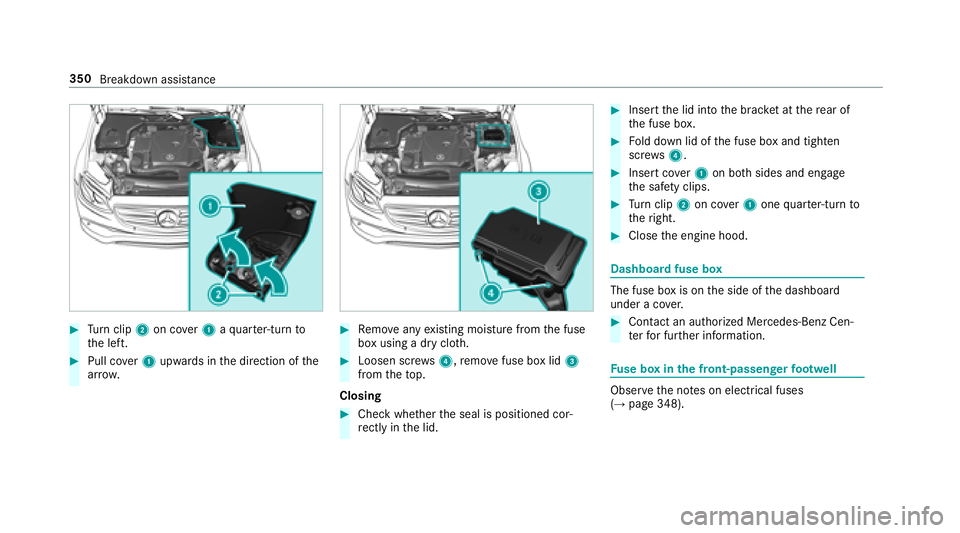
00BBTurn clip 2on co ver1 aqu arter-turn to
th e left.
00BBPull co ver1 upwards in the direction of the
ar row .
00BBRemo veany existing moisture from the fuse
box using a dry clo th.
00BBLoosen scr ews4, remo vefuse box lid 3
from theto p.
Closing
00BBCheck whe ther the seal is positioned cor‐
re ctly in the lid.
00BBInsert the lid into the brac ket at there ar of
th e fuse box.
00BBFo ld down lid of the fuse box and tighten
scr ews4.
00BBInsert co ver1 on bo thsides and engage
th e saf etyclips.
00BBTu rn clip 2on co ver1 one quarter-turn to
th eright.
00BBClose the engine hood.
Dashboard fuse box
The fuse box is on the side of the dashboard
under a co ver.
00BBConta ct an au thorized Mercedes-Benz Cen‐
te rfo r fur ther information.
Fu se box in the front-passenger foot we ll
Obser vethe no tes on electrical fuses
(→page 348).
350 Breakdown assis tance
Page 353 of 498
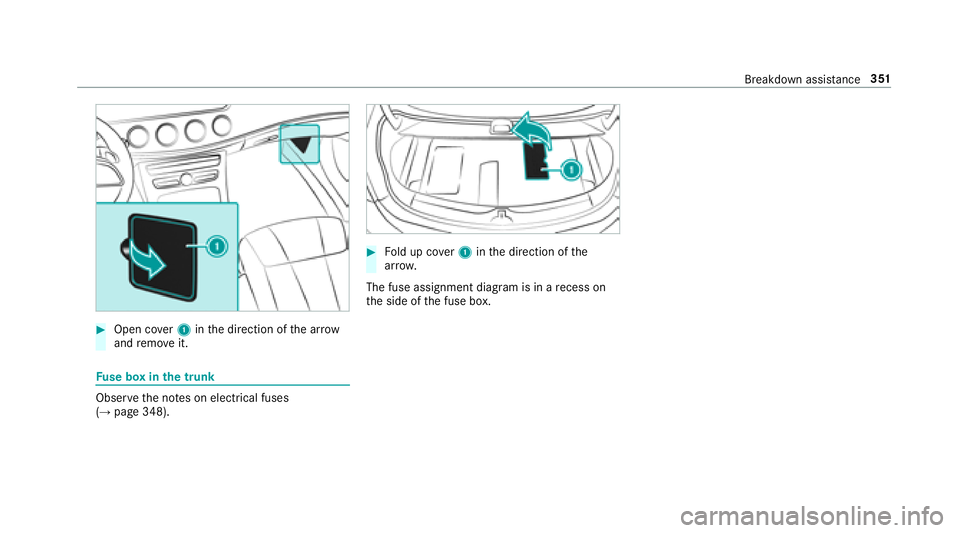
00BBOpen cover1 inthe direction of the ar row
and remo veit.
Fuse box in the trunk
Obser vethe no tes on electrical fuses
(→page 348).
00BBFo ld up co ver1 inthe direction of the
ar row .
The fuse assignment diagram is in a recess on
th e side of the fuse box.
Breakdown assis tance 351
Page 354 of 498
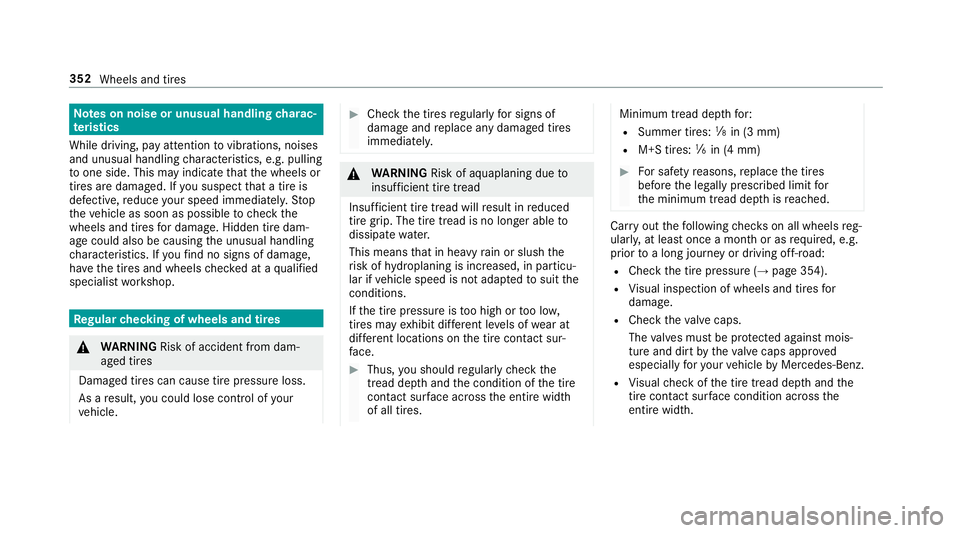
Notes on noise or unusual handling charac‐
te rist ics
While driving, pay attention tovibrations, noises
and unusual handling characteristics, e.g. pulling
to one side. This may indicate that the wheels or
tires are damaged. If you suspect that a tire is
defective, reduce your speed immediatel y.Stop
th eve hicle as soon as possible tocheck the
wheels and tires for dama ge. Hidden tire dam‐
age could also be causing the unusual handling
ch aracteristics. If youfind no signs of damage,
ha ve the tires and wheels checked at a qualified
specialist workshop.
Re gular checking of wheels and tires
0071
WARNING Risk of accident from dam‐
aged tires
Dama ged tires can cause tire pressure loss.
As a result, you could lose cont rol of your
ve hicle.
00BBCheck the tires regularly for signs of
dama geand replace any damaged tires
immediatel y.
0071
WARNING Risk of aquaplaning due to
insuf ficient tire tread
Insuff icient tire tread will result in reduced
tire grip. The tire tread is no longer able to
dissipate water.
This means that in heavy rain or slush the
ri sk of hydroplaning is increased, in particu‐
lar if vehicle speed is not adap tedto suit the
conditions.
If th e tire pressure is too high or too lo w,
tires may exhibit dif fere nt le vels of wear at
dif fere nt locations on the tire conta ct sur‐
fa ce.
00BBThus, you should regularly check the
tread de pth and the condition of the tire
conta ct surf ace across the entire width
of all tires.
Minimum tread dep thfor:
RSummer tires: 00CEin (3 mm)
RM+S tires: 00CFin (4 mm)
00BBFor saf etyre asons, replace the tires
before the legally prescribed limit for
th e minimum tread dep thisreached.
Car ryout thefo llowing checks on all wheels reg‐
ularly, at least once a month or as requ ired, e.g.
prior toa long journey or driving off- road:
RCheck the tire pressure (→page 354).
RVisual inspection of wheels and tires for
damage.
RCheck theva lve caps.
The valves must be pr otected against mois‐
ture and dirt bytheva lve caps appr oved
especially foryo ur vehicle byMercedes-Benz.
RVisual check of the tire tread dep thand the
tire contact surf ace condition across the
entire width.
352 Wheels and tires
Page 355 of 498
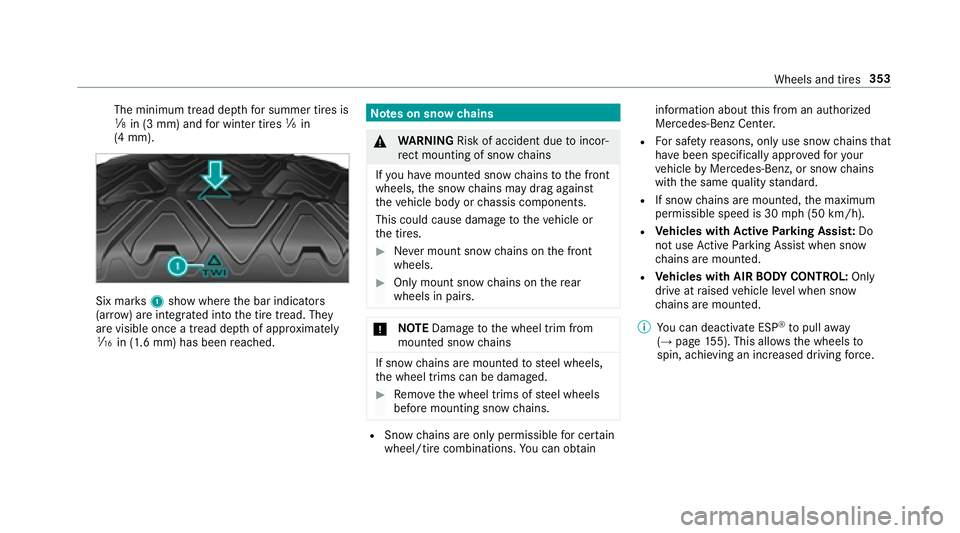
The minimum tread depthfor summer tires is
00CE in (3 mm) and for winter tires 00CFin
(4 mm).
Six mar ks1 show where the bar indicators
(ar row ) are integrated into the tire tread. They
are visible once a tread dep thof appr oximately
00CD in (1.6 mm) has been reached.
Note s on snow chains
0071
WARNING Risk of accident due toincor‐
re ct mounting of snow chains
If yo u ha vemounted snow chains tothe front
wheels, the snow chains may drag against
th eve hicle body or chassis components.
This could cause damage totheve hicle or
th e tires.
00BBNe ver mount snow chains on the front
wheels.
00BBOnly mount snow chains on there ar
wheels in pairs.
0075 NO
TEDama getothe wheel trim from
mounted snow chains
If snow ch ains are mounte dto steel wheels,
th e wheel trims can be damaged.
00BBRe mo vethe wheel trims of steel wheels
before mounting snow chains.
RSn ow chains are only pe rmissible for cer tain
wheel/tire combinations. You can obtain information about
this from an authorized
Mercedes-Benz Center.
RFo r saf etyre asons, only use snow ch ainsthat
ha ve been specifically appr oved foryo ur
ve hicle byMercedes-Benz, or snow chains
with the same quality standard.
RIf snow ch ains are moun ted, the maximum
permissible speed is 30 mph (50 km/h).
RVehicles with Active Parking Assis t:Do
no t use Active Parking Assist when snow
ch ains are mounte d.
RVehicles with AIR BODY CONT ROL:Only
drive at raised vehicle le vel when snow
ch ains are mounte d.
00CE You can deactivate ESP
®to pull away
(→page 155). This allo wsthe wheels to
spin, achieving an increased driving forc e.
Wheels and tires 353
Page 356 of 498
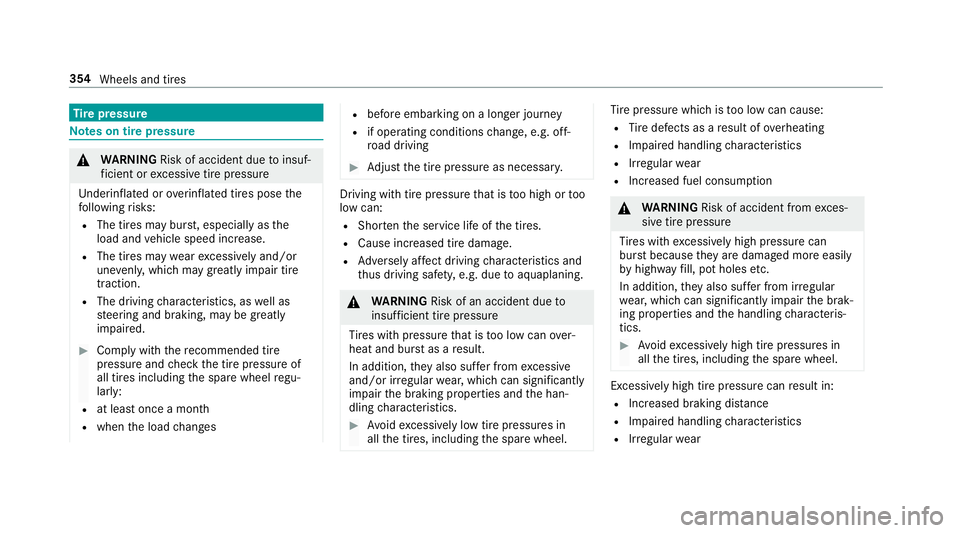
Tire pressure
Note s on tire pressure
0071
WARNING Risk of accident due toinsuf‐
fi cient or excessive tire pressure
Underinfla ted or overinfla ted tires pose the
fo llowing risks:
RThe tires may bur st, especially as the
load and vehicle speed increase.
RThe tires may wearexc essively and/or
une venly, which may greatlyimpair tire
traction.
RThe driving characteristics, as well as
st eering and braking, may be greatly
impaired.
00BBComply with there commended tire
pressure and check the tire pressure of
all tires including the spare wheel regu‐
larly:
Rat least once a month
Rwhen the load changes
Rbefore embarking on a longe r journey
Rif operating conditionschange, e.g. off-
ro ad driving
00BBAd just the tire pressure as necessar y.
Driving withtire pressure that is too high or too
low can:
RSho rten the service life of the tires.
RCause increased tire damage.
RAd versely af fect driving characteristics and
th us dr iving saf ety, e.g. due toaquaplaning.
0071
WARNING Risk of an accident due to
insuf ficient tire pressure
Ti re s with pressure that is too low can over‐
heat and bur stas a result.
In addition, they also suf fer from excessive
and/or ir regular wear, which can significantly
impair the braking properties and the han‐
dling characteristics.
00BBAv oid excessively low tire pressures in
all the tires, including the spare wheel.
Tire pressure which is too low can cause:
RTire defects as a result of overheating
RImpaired handling characteristics
RIrre gular wear
RIncreased fuel consum ption
0071
WARNING Risk of accident from exces‐
sive tire pressure
Ti re s with excessively high pressure can
bur stbecause they are damaged more easily
by highw ayfill, pot holes etc.
In addition, they also suf fer from ir regular
we ar, which can significantly impair the brak‐
ing properties and the handling characteris‐
tics.
00BBAv oid excessively high tire pressures in
all the tires, including the spare wheel.
Excessively high tire pressure can result in:
RIncreased braking dis tance
RImpaired handling characteristics
RIrre gular wear
354
Wheels and tires
Page 357 of 498
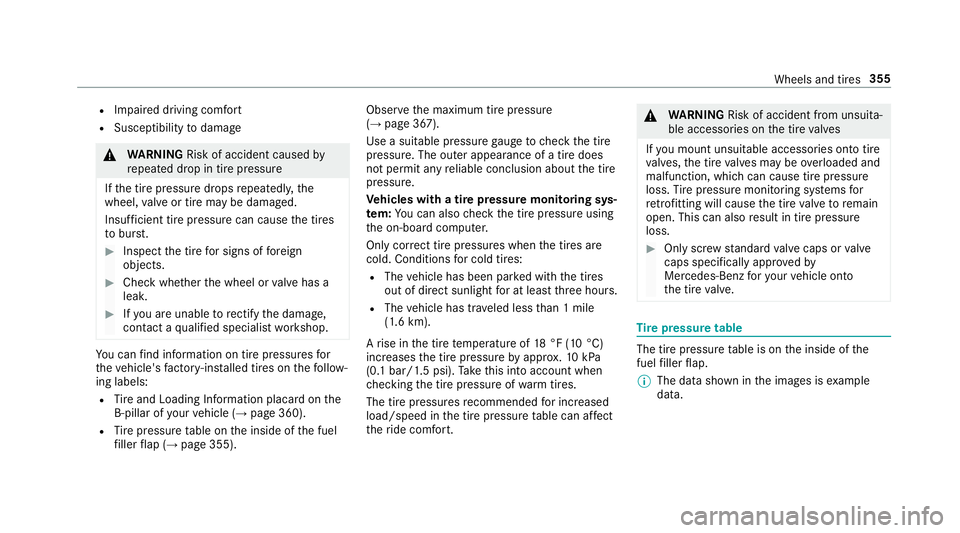
RImpaired driving comfort
RSusceptibility todamage
0071
WARNING Risk of accident caused by
re peated drop in tire pressure
If th e tire pressure drops repeatedly, the
wheel, valve or tire may be damaged.
Insuf ficient tire pressure can cause the tires
to bur st.
00BBInspect the tire for signs of fore ign
objects.
00BBCheck whe ther the wheel or valve has a
leak.
00BBIf yo u are unab leto rectify the damage,
conta ct aqualified specialist workshop.
Yo u can find information on tire pressures for
th eve hicle's factor y-ins talled tires on thefo llow‐
ing labels:
RTi re and Loading Info rmation placard on the
B‑pillar of your vehicle (→page 360).
RTire pressure table on the inside of the fuel
fi ller flap (→page 355). Observ
eth e maximum tire pressure
(
→page 367).
Use a suitable pressure gauge tocheck the tire
pressure. The outer appearance of a tire does
not permit any reliable conclusion about the tire
pressure.
Ve hicles with a tire pressure monitoring sys‐
te m: You can also check the tire pressure using
th e on-board computer.
Only cor rect tire pressures when the tires are
cold. Conditions for cold tires:
RThe vehicle has been par ked with the tires
out of direct sunlight for at least thre e hours.
RThe vehicle has tr aveled less than 1 mile
(1.6 km).
A rise in the tire temp erature of 18°F (10 °C)
increases the tire pressure byappr ox.10 kPa
(0.1 bar/1.5 psi). Take this into account when
ch ecking the tire pressure of warm tires.
The tire pressure sre commended for increased
load/speed in the tire pressure table can af fect
th eride comfort.
0071
WARNING Risk of accident from unsuita‐
ble accessori es onthe tire valves
If yo u mount unsuitable accessories onto tire
va lves, the tire valves may be overloaded and
malfunction, which can cause tire pressure
loss. Tire pressure monitoring sy stems for
re trofitting will cause the tire valve toremain
open. This can also result in tire pressure
loss.
00BBOnly scr ewstandard valve caps or valve
caps specifically appr ovedby
Mercedes-Benz foryo ur vehicle onto
th e tire valve.
Ti re pressure table
The tire pressure table is on the inside of the
fuel filler flap.
00CE The data shown in the images is example
data.
Wheels and tires 355
Page 358 of 498
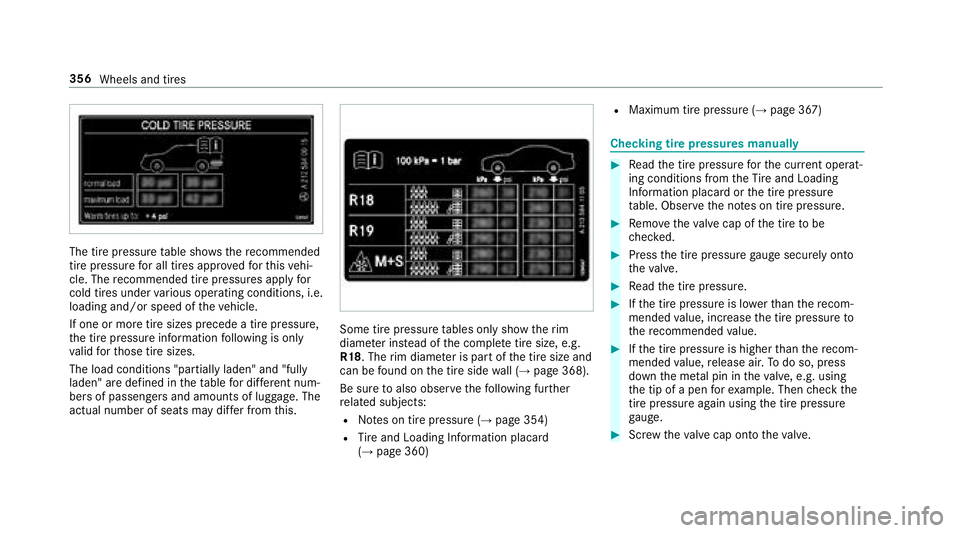
The tire pressuretable sho ws there commended
tire pressure for all tires app rove dfo rth is vehi‐
cle. The recommended tire pressures apply for
cold tires under various operating conditions, i.e.
loading and/or speed of theve hicle.
If one or more tire sizes precede a tire pressure,
th e tire pressure information following is only
va lid forth ose tire sizes.
The load conditions "partially laden" and "fully
laden" are defined in theta ble for dif fere nt num‐
be rs of passengers and amounts of luggage. The
actual number of seats may dif fer from this.
Some tire pressure tables only show therim
diame ter ins tead of the comple tetire size, e.g.
R18 . The rim diame ter is part of the tire size and
can be found on the tire side wall (
→page 368).
Be sure toalso observ eth efo llowing fur ther
re lated subjects:
RNo tes on tire pressure (→page 354)
RTire and Loading Info rmation placard
(→page 360)
RMaximum tire pressure (→page 367)
Checking tire pressure s manually
00BBRead the tire pressure forth e cur rent operat‐
ing conditions from theTire and Loading
Info rmation placard or the tire pressure
ta ble. Obser vethe no tes on tire pressure.
00BBRe mo vetheva lve cap of the tire tobe
ch ecked.
00BBPress the tire pressure gauge securely onto
th eva lve.
00BBRe ad the tire pressure.
00BBIfth e tire pressure is lo werth an there com‐
mended value, inc rease the tire pressure to
th ere commended value.
00BBIfth e tire pressure is higher than there com‐
mended value, release air. Todo so, press
down the me tal pin in theva lve, e.g. using
th e tip of a pen forex ample. Then check the
tire pressure again usingthe tire pressure
ga uge.
00BBSc rew theva lve cap onto theva lve.
356
Wheels and tires
Page 359 of 498
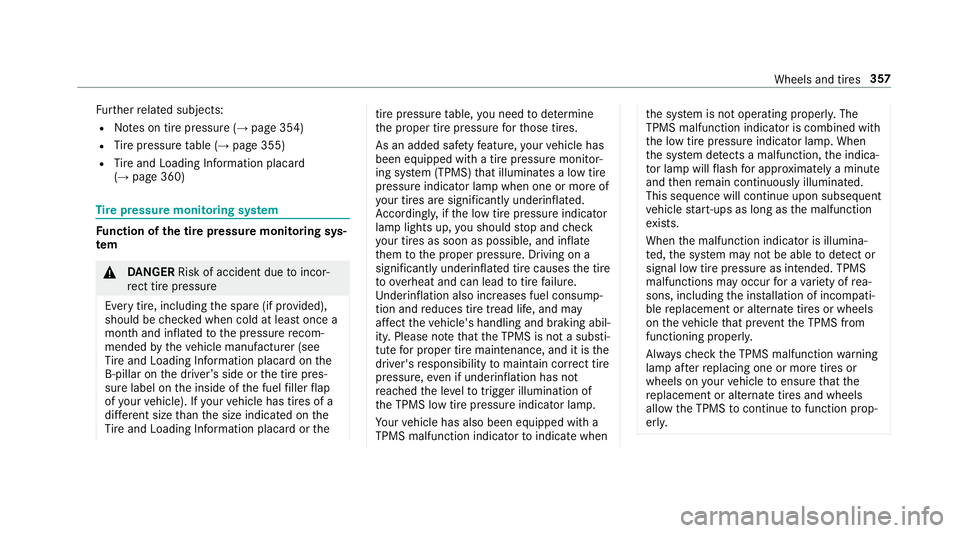
Further related subjects:
RNo tes on tire pressure (→page 354)
RTire pressure table (→page 355)
RTire and Loading Info rmation placard
(→page 360)
Ti re pressure moni toring sy stem
Fu nction of the tire pressure moni toring sys‐
te m
0071
DANG ER Risk of accident due toincor‐
re ct tire pressure
Every tire, including the spare (if pr ovided),
should be checked when cold at least once a
month and inflated tothe pressure recom‐
mended bytheve hicle manufacturer (see
Ti re and Loading Info rmation placard on the
B-pillar on the driver ’sside or the tire pres‐
sure label on the inside of the fuel filler flap
of your vehicle). If your vehicle has tires of a
dif fere nt size than the size indicated on the
Ti re and Loading Info rmation placard or the
tire pressure table, you need todeterm ine
th e proper tire pressure forth ose tires.
As an added saf etyfe ature, your vehicle has
been equipped with a tire pressure monitor‐
ing sy stem (TPMS) that illuminates a low tire
pressure indicator lamp when one or more of
yo ur tires are signif icantly underinflated.
Ac cording ly, if the low tire pressure indicator
lamp lights up, you should stop and check
yo ur tires as soon as possible, and inflate
th em tothe proper pressure. Driving on a
significant lyunderinflated tire causes the tire
to ov erheat and can lead totire failure.
Un derinflation also increases fuel consump‐
tion and reduces tire tread life, and may
af fect theve hicle's handling and braking abil‐
ity. Please no tethat the TPMS is not a substi‐
tute for proper tire maintenance, and it is the
driver's responsibility tomaintain cor rect tire
pressure, even if underinflation has not
re ached the le velto trig ger illumination of
th e TPMS low tire pressure indicator lamp.
Yo ur vehicle has also been equipped with a
TPMS malfunction indicator toindicate whenthe sy stem is not operating proper ly. The
TPMS malfunction indica tor is combined with
th e low tire pressure indicator lamp. When
th e sy stem de tects a malfunction, the indica‐
to r lamp will flash for app roxima tely a minute
and then remain continuously illumina ted.
This sequence will continue upon subsequent
ve hicle start-ups as long as the malfunction
ex ists.
When the malfunction indicator is illumina‐
te d, the sy stem may not be able todetect or
signal low tire pressure as intended. TPMS
malfunctions may occur for a variet yof rea‐
sons, including the ins tallation of incompati‐
ble replacement or alternate tires or wheels
on theve hicle that pr eventthe TPMS from
functioning properly.
Alw aysch eck the TPMS malfunction warning
lamp af terre placing one or more tires or
wheels on your vehicle toensure that the
re placement or alternate tires and wheels
allow the TPMS tocontinue tofunction prop‐
erly.
Wheels and tires 357
Page 360 of 498

The system checks the tire pressure and the tire
te mp erature of the tires fitted totheve hicle by
means of a tire pressure sensor.
New tire pressure sensors, e.g. in winter tires,
are automatically taught-in thefirs t time they are
driven.
The tire pressure and the tire temp erature
appear in the multifunction display
(
→page 202).
If th ere is a subs tantial pressure loss or if the
tire temp erature is excessive, a warning will be
given:
RVi a display messages (→page 425).
RViath e0077 warning lamp in the instrument
clus ter (→page 459).
It is the driver's responsibility toset the tire
pressure tothere commended cold tire pressure
suitable forth e operating situation. Set the tire
pressure for cold tires using a tire pressure
ga uge. Notethat the cor rect tire pressure forth e
cur rent operating situation must firs t be taught-
in to the tire pressure monitoring sy stem. In most cases,
the tire pressure monitoring sys‐
te m will auto matically update the new refere nce
va lues af teryo u ha vechanged the tire pressure.
Yo u can, ho wever,also update there fere nce val‐
ues byrestarting the tire pressure mon
itoring
sy stem manually (→page 359).
Sy stem limitations
The sy stem may be impaired or may not function
in thefo llowing situations:
RIf th e tire pressure is set incor rectly.
RIfth ere is a sudden pressure loss caused, for
ex ample, byafo re ign object penetrating the
tire.
RIf th ere is a malfunction caused byano ther
ra dio signal source.
Make sure toobser vethefo llowing fur ther rela‐
te d subjec t:
RNotes on tire pressure (→page 354)
Checking the tire pressure with the tire pres‐
sure moni toring sy stem
Requ irement:
RThe ignition is switched on. On-board computer:
0086�6�H�U�Y�L�F�H00CF�7�L�U�H�V
One of thefo llowing displa ysappears:
RCur rent tire pressure and tire temp erature of
th e individual wheels:
R�7�L�U�H �S�U�H�V�V�X�U�H �Z�L�O�O �E�H �G�L�V�S�O�D�\�H�G �D�I�W�H�U �G�U�L�Y�L�Q�J �D
�I�H�Z �P�L�Q�X�W�H�V
R�7�L�U�H �3�U�H�V�V�X�U�H �0�R�Q�L�W�R�U �$�F�W�L�Y�H: thete ach-in
process of the sy stem is not yet comple te.
The tire pressures are already being moni‐
to re d.
00BBCompare the tire pressure with there com‐
mended tire pressure forth e cur rent operat‐
358
Wheels and tires